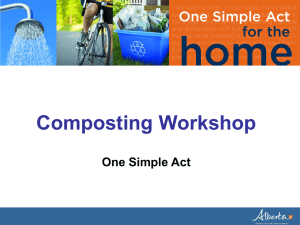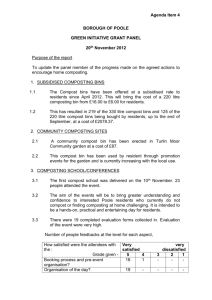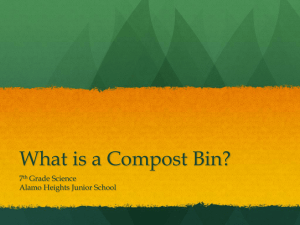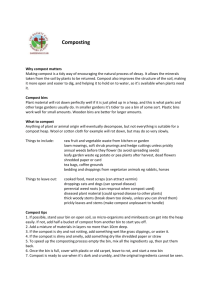File - The Compost Crusaders
advertisement
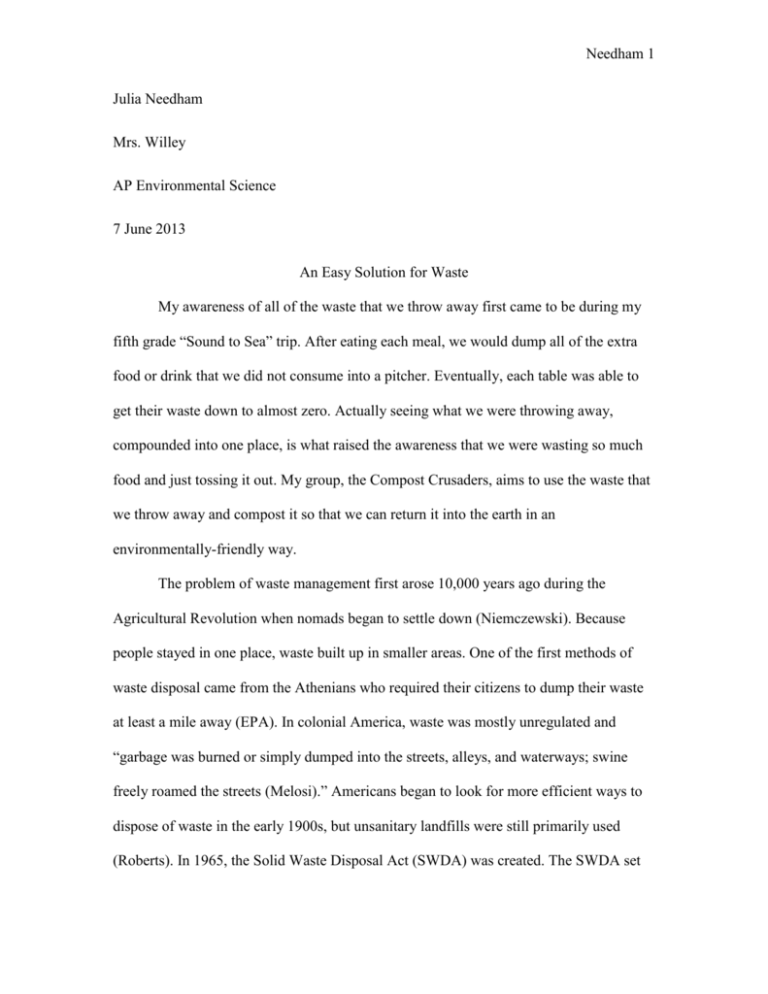
Needham 1 Julia Needham Mrs. Willey AP Environmental Science 7 June 2013 An Easy Solution for Waste My awareness of all of the waste that we throw away first came to be during my fifth grade “Sound to Sea” trip. After eating each meal, we would dump all of the extra food or drink that we did not consume into a pitcher. Eventually, each table was able to get their waste down to almost zero. Actually seeing what we were throwing away, compounded into one place, is what raised the awareness that we were wasting so much food and just tossing it out. My group, the Compost Crusaders, aims to use the waste that we throw away and compost it so that we can return it into the earth in an environmentally-friendly way. The problem of waste management first arose 10,000 years ago during the Agricultural Revolution when nomads began to settle down (Niemczewski). Because people stayed in one place, waste built up in smaller areas. One of the first methods of waste disposal came from the Athenians who required their citizens to dump their waste at least a mile away (EPA). In colonial America, waste was mostly unregulated and “garbage was burned or simply dumped into the streets, alleys, and waterways; swine freely roamed the streets (Melosi).” Americans began to look for more efficient ways to dispose of waste in the early 1900s, but unsanitary landfills were still primarily used (Roberts). In 1965, the Solid Waste Disposal Act (SWDA) was created. The SWDA set Needham 2 up a national plan to manage waste and provided financial and technical resources for local and state governments (Hickman). Then, in 1967, the United States passed the Resource Conservation and Recovery Act which regulates solid and hazardous wastes (Rauch). The current situation of waste disposal is much different than it was 300 years ago. Although solid waste disposal is much more sanitary and safe, millions of tons of waste are created by Americans every year. In 2010, that number was 250 million tons (EPA). The EPA also says that, “Food scraps (30,990 tons) were 12.7% of waste generated 2008, while yard trimmings were 13.2%,” but that, “Only 2.5% of all waste food was composted in 2008 – the rest went to landfill or incinerators.” It also estimates that 42% of United States greenhouse emissions could be reduced through recycling and composting. In order to achieve this reduction in greenhouse gases, the action we took was to construct our own compost bin to deposit waste into. First we poked holes into a large trash bin to allow air to circulate. Then, we dug a shallow hole in Elizabeth’s backyard to put our compost bin into. Compost bins tend to attract insects and rodents so we placed the bin a good distance from the house. An important part of composting is to create a good base, so for the first layer we added in old grass clippings. After that, many kinds of waste can be added to the compost bin, even things like paper napkins, wine corks, and dryer lint. The outcome was that Elizabeth’s household was able to reduce their trash output by 32%! Overall, the project went really well. The compost bin was easy enough to construct, and the only difficult part will have to turn the compost every so often to aerate Needham 3 it. The worst part of the process was having to add in the grass clippings because there were lots of ants and it was difficult to rake the clippings from the wheelbarrow to the bin. The planning went very well and both of my group members were very easy to work with and reliable. Everyone did their fair share of the project, and we all worked together to construct our compost bin. I think our idea of making a compost bin was a good one because it is an easy way to reduce the amount of waste that we throw away. Plus, anyone can do it! Even if someone lives in an apartment where they do not have access to a backyard like we did, they could make a communal compost bin in which everyone in the apartment complex could participate. Something that we could have done differently would be to place the bin in a different spot in the backyard. It was smart that we put it away from the house, but we should not have put it into the woods. Putting it out in the open would decrease the amount of pests because they tend to live in the woods, and it would also allow more sunlight to reach the compost, which would in turn allow the decomposition to occur more quickly. Something else that we could have done was to maybe use a different type of bin instead of the trash bin. The trash bin, although it had holes, still had a lot of closed space around the compost, reducing aeration and sunlight exposure. Something more open like a chicken-wire bin might be a better material to use. But for the time and materials that we had, I think we did a good job. I would love to continue this process out of school. My mom and I used to have a small compost bin but we eventually stopped using it. This project could be the perfect kick-start to making our own functional compost bin again. Because the project also required me to do some research on composting, I found out a lot of things that I did not Needham 4 know before, especially all of things that you can compost, and not just organic waste! Everything from used matches to pet fur can be added into the compost bin. The Compost Crusaders has finished this school project, but we will continue on composting. Needham 5 Works Cited Hickman, H. Lanier, Jr., "A Brief History of Solid Waste Management in the US, 1950 2000, Part 5a: Building an Infrastructure." Melosi, Martin V., The Sanitary City, Baltimore: The Johns Hopkins University Press, 2000, 18,19. Niemczewski, Christopher, "The History of Solid Waste Management," Chap. 2 in The Organization and Efficiency of Solid Waste Collection, New York: The Trustees of Columbia University, 1977. Rauch, Barbara, "Infamis Aer, Dragons and Fiery Rivers: Historical Background of America's Environmental Laws," The Oklahoma Bar Journal, 76, no. 24 (September 3, 2005). Roberts, Jon. "A Brief History of Waste Regulation in the United States and Oklahoma." Oklahoma Department of Environmental Quality. State of Oklahoma, 2011. Web. U. S. Environmental Protection Agency, "Milestones in Garbage: A historical timeline of municipal solid waste management," February 22, 2006, <http://www.epa.gov/msw/timeline_alt.htm> (February 28, 2007). U.S. Environmental Protection Agency, "Municipal Solid Waste Generation, Recycling, and Disposal in the United States" N.p., Dec. 2011.

